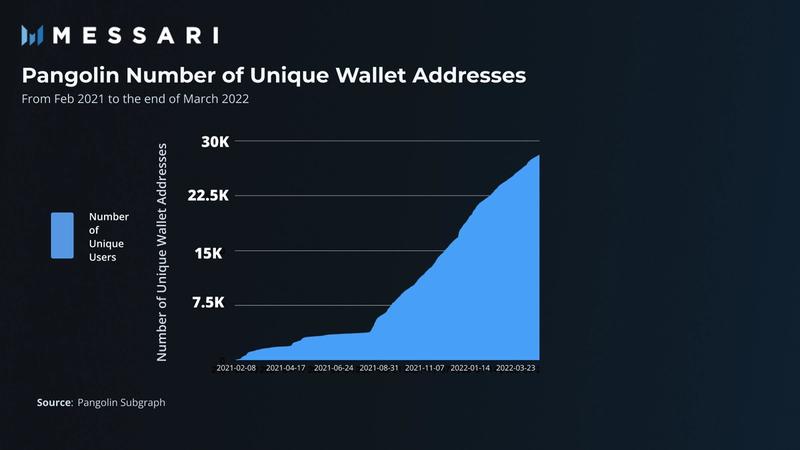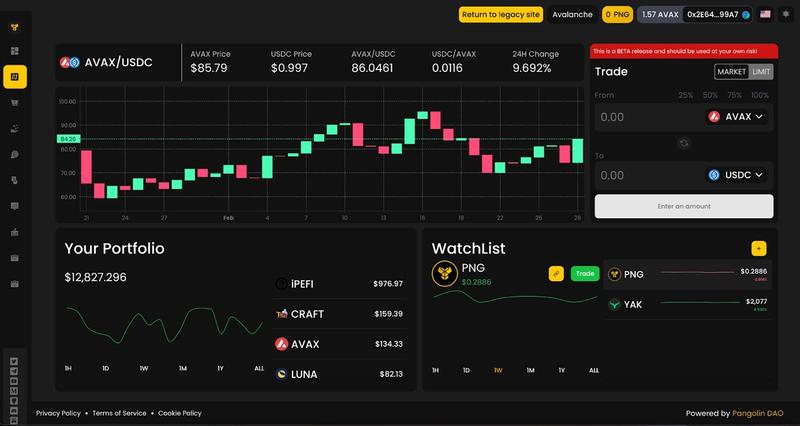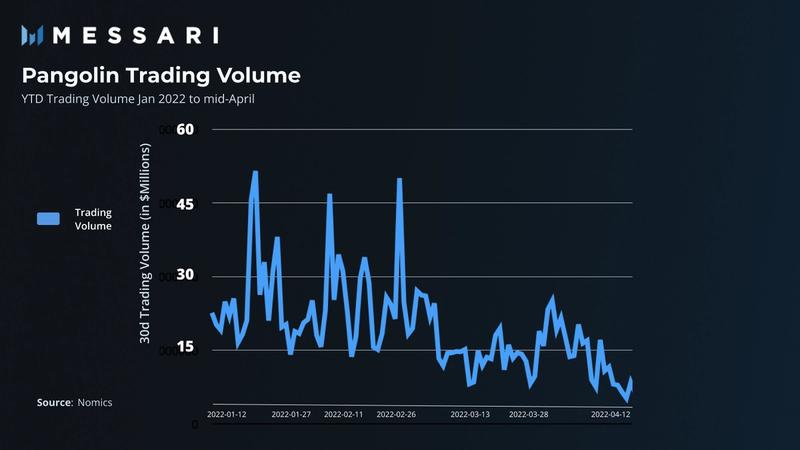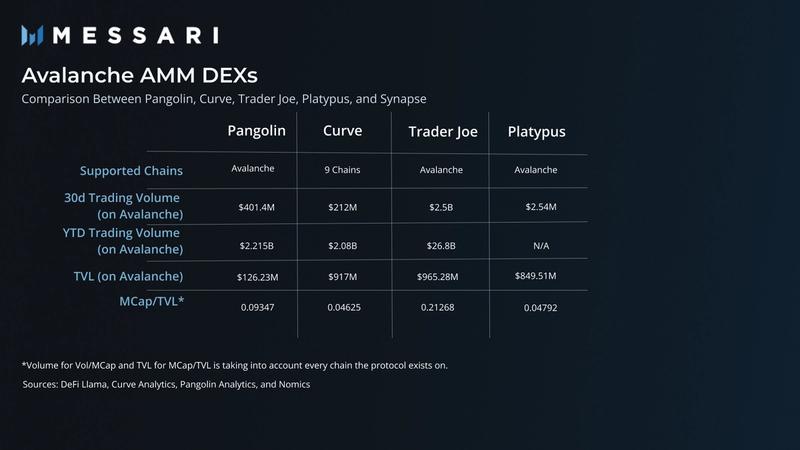Key Insights
- Pangolin Exchange is a top two AMM-powered DEXs on Avalanche by trading volume
- Pangolin is community-driven, as is reflected in the 100% token distribution to its community.
- The protocol is currently building out a cross-chain ecosystem, starting with NEAR Protocol. The team plans to operate on multiple chains and support various multichain wallets.
Introduction
As Ethereum’s DeFi applications gained traction, scalability issues became increasingly apparent as gas fees on the blockchain’s ecosystem skyrocketed. The fees were often too high to justify the intended transactions of Ethereum DEX users. For these users, along with those simply looking for cheaper and faster platforms, newer blockchain ecosystems became attractive options.
Avalanche is one of the blockchains where users sought refuge from Ethereum’s congestion problems. Avalanche was launched in September 2020, and it promised to be faster, cheaper, and more flexible than Ethereum. This new blockchain called for the construction of its own DeFi ecosystem, complete with an automated market maker (AMM)-powered decentralized exchange (DEX). The Ava Labs team created Pangolin, but now operations are run and decisions are made by the stakeholders in the community. In this report, we will introduce the Pangolin Exchange, its tokenomics, traction, competitive landscape, risks, and roadmap.
Pangolin: Community-Driven and Built on Avalanche
Pangolin was launched as the Avalanche equivalent of Uniswap V2 on Ethereum. Ava Labs launched the protocol in February 2021 and it intended to solve two problems facing AMMs: 1) slow performance, particularly on other chains, and 2) the centralized governance of a few large stakeholders.
How Pangolin Offers Fast and Cheap Trades
Pangolin inherits several of the advantages that Avalanche has over Ethereum. Avalanche is much faster than Ethereum. It can execute 4,500 transactions per second (TPS) while Ethereum only supports 13 TPS. Because Pangolin is built on Avalanche, the protocol can achieve more transactions than other AMM DEXs on Ethereum. In addition, Avalanche’s lower gas fees make trading on Pangolin cheaper than Ethereum-based AMMs. The competitive analysis section in this paper will give a more in-depth comparison of Pangolin and other AMM DEXs.
How Pangolin Prioritizes Community-Driven Development
In the pursuit of true decentralization, Pangolin distributes 100% of its governance tokens, PNG, to its community. As of April 23, 2022, there are over 30,000 unique addresses holding PNG. The tokens are not allocated to the team, its advisors and investors, or any other insiders.
The community of tokenholders can use their PNG to vote on specific proposals to change the Pangolin protocol. These proposals can range from adjusting liquidity mining pool options to modifying the protocol’s fee structure.

Pangolin Core Features and Offerings
There is no shortage of AMM DEXs in DeFi, and Pangolin has dedicated itself to launching smart, convenient features that set itself apart from competitors. Some of these features include limit orders, Super Farms, and other useful tools.
User Experience for Generic Swaps
The protocol has a visually appealing and self-explanatory user interface, shown below. Traders pay a 0.3% fee that is paid out to three parties: 1) with 0.25% paid to liquidity providers, 2) 0.0425% paid to PNG stakers, and 3) 0.0075% paid to Pangolin DAO’s swap fees wallet.

Limit Orders
Pangolin users can place limit orders on any tokens on the platform. Users pay a fee for initiating and canceling limit orders. Pangolin’s slippage for their limit orders is held at 0.4%. One such popular use case for limit orders is an arbitrage strategy which profits from temporary stablecoin price fluctuations.
Liquidity Mining Program
Pangolin’s liquidity mining program launched at mainnet and distributed PNG to pools with AVAX and PNG as base assets. Pools for AVAX include but are not limited to: AVAX/ETH, AVAX/USDT, AVAX/PNG, and AVAX/LINK. Pools for PNG include but are not limited to: PNG/ETH, PNG/USDT, and PNG/DAI. When the base asset within a pool is not AVAX, then the pool’s liquidity is calculated with the base asset’s value proportional to AVAX.
Super Farms
Pangolin’s Super Farms is a liquidity bootstrapping initiative to help garner more liquidity. Many of these Super Farms are simultaneously offering several, sometimes even 10, different reward tokens. Examples of Pangolin partners who are offering tokens include Lost Worlds (LOST), Kalao (KLO), and Heroes Chained (HEC).
Pangolin Partnership Integrations and Co-Development
Gnosis Multisig Wallet and Tool
Pangolin is integrated with the Gnosis Multisig Wallet, which is a highly secure wallet that requires multiple confirmations of the same transaction. The Gnosis Multsig Tool includes multi-signatures while retaining privacy and its open-source structure.
Bonds on Olympus Pro
Pangolin’s integration with Olympus Pro’s Bond program will allow users to receive PNG from their liquidity provider (LP) tokens. This partnership would cushion Pangolin’s long-term liquidity.
MoonPay Integration
MoonPay is essentially a PayPal for DeFi. The integration with MoonPay allows Pangolin users to seamlessly purchase cryptocurrency with their credit cards through MoonPay. The tokens available for purchase include: AVAX, UST, LUNA, NEAR, HBAR, and ATOM. After users finalize their transactions with MoonPay, the tokens are instantly placed into their connected wallets.
NFTrade Co-Development
Pangolin released a collection of 16 different NFTs, each with 100 copies. The program encourages users who wish to collect an NFT to stake PNG on NFTrade.com.
Tokenomics
As mentioned previously, 100% of Pangolin’s PNG tokens are distributed to the community. The protocol’s original litepaper suggested that the total supply would be capped at 538 million tokens. The paper also described an algorithmically powered vesting schedule that would release 256 million tokens for the first four years and then 50% of the previous release for every subsequent four-year cycle. After a proposal to change these tokenomics was approved in September 2021, the maximum total token supply dropped to 230 million.
The original tokenomics allocated 95% of tokens to fund liquidity mining with 5% reserved for an airdrop. As of now, about 83% of PNG is allocated to liquidity providers, and 13% is allocated to the treasury. According to CoinMarketCap, the current circulating supply of PNG is approximately 94.6 million. In addition to being a governance token, PNG is also a utility token that pays 0.0425% of Pangolin trades to the PNG staking pool.
Traction
From mid-March to mid-April 2022, Pangolin’s 30-day trading volume was $401.4 million. Its year-to-date (YTD) trading is $2.2 billion. In the graphs below, Pangolin’s YTD trading volume trends down, but this followed the overall volume decrease in DEX markets and downturn in DeFi markets.

Pangolin also experienced an influx of recent partnership announcements. Its recent partnership with Avalanche Rush, an ecosystem growth allocation program, could indicate potential ecosystem growth. This program would distribute $2 million worth of AVAX rewards to Pangolin’s DEX along with additional LUNA and PNG rewards. The rewards are allocated to Pangolin’s Super Farms to attract more liquidity and traction.
Competitive Landscape
Pangolin’s relatively low ratio of market capitalization to TVL may be an indicator that the protocol is undervalued. In the graph below, YTD trading volume fluctuations for Pangolin, Curve, and Trader Joe follow similar overall trends that correspond to DEX market conditions.

Risks
Pangolin faces similar risks as other AMM-powered DEXs, including low capital efficiency.
Low Capital Efficiency
Capital efficiency refers to the level of liquidity that is being intelligently allocated to generate revenue. Historically, AMMs have been less capital efficient than their order-book counterparts. Order-book exchanges can set trading prices to optimize liquidity utilization. AMM liquidity providers cannot directly influence quoted trading prices, making it harder for them to efficiently allocate liquidity.
Concentrated liquidity solutions, such as Uniswap V3, mitigate these risks. Pangolin has not announced plans to deploy a concentrated liquidity product, but they could be taking a different approach. This alternative approach is to increase capital efficiency by sourcing liquidity across multiple ecosystems. Pangolin has announced plans to deploy on various networks, starting with NEAR. If they are able to defragment the liquidity that will be sitting on these disparate chains, then they can dramatically increase capital efficiency.
Roadmap
Pangolin’s Q2 2022 roadmap builds on their Q1 developments and seeks to strengthen its community loyalty. Pangolin’s Q2 2022 roadmap includes: 1) updates that reinforce community loyalty, 2) the development of cross-chain capabilities, and 3) the expansion of revenue streams through product development/updates.
Community Loyalty
Pangolin has developed a new staking mechanism to calculate user rewards while considering the length of time users’ capital was staked.The team branded this the Sunshine and Rainbows (SAR) algorithm. Its goal is to discourage rewards dumping and encourage capital staking for longer periods of time. SAR will be offered in all staking pools, including single-staking ones.
In addition to financial rewards, loyal Pangolin community members can also look forward to new private Discord channels that release Pangolin-related alpha and extensive insider reports on DAO operations.
Cross-Chain Capabilities
Pangolin has plans to build on NEAR and will launch airdrop campaigns to market its new platform. To execute its cross-chain strategy and ensure smooth airdrop operations, Pangolin will embed Axelar and Wormhole bridges in its platform’s user interface (UI). Pangolin can use Wormhole’s cross-chain bridges to move native assets on other chains. Axelar’s cross-chain capabilities will add yet another layer of interoperability for Pangolin. It is not simply a bridge but a security mechanism that validates cross-chain asset movements because assets can only be moved across chains when the network reaches consensus.
Depending on how the Pangolin team aggregates liquidity across chains in the future, multiple chains could share liquidity and lower their capital efficiency risks. The protocol will also build out its new multichain ecosystem by providing more wallet options, including xDEFI, Rabby wallet, NEAR wallet, and more. Pangolin aims to expand its multi-chain community and is actively prospecting other chains for potential integrations. The protocol’s promise to build and strengthen community could be one of its most attractive value propositions for attracting multichain traction.
Other AMM DEXs, like Uniswap V3, have proven that multi-chain ecosystems attract and retain traction. Uniswap’s organic success on Polygon is a prime example of how multi-chain capabilities can support protocol growth. Uniswap V3 had an 81.7% jump in liquidity on Polygon in Q1 2022 even as the overall market liquidity dropped and liquidity mining incentives scaled back. One possible explanation for Uniswap V3’s success on Polygon is due to the popularity of blue chip token pairs on that platform, which are likely to trade with lower fees. Meanwhile, Uniswap V3 expansions on chains that focused on token pairs with higher fees, like Arbitrum, performed less stellar.
Product Updates
In Q2 2022, Pangolin V2 will graduate from its beta mode, which sported new interactive features and a more attractive UI. Q2’s upcoming product updates include DEX as a Service or DaaS, which will allow applications to include Pangolin’s swap widget on their platform. The feature will drive more traffic to Pangolin, thereby increasing its trading volume and daily active users. Along with other developments, the Pangolin team will add Zap, a feature which effortlessly permits users to transition from single- to double-sided LP without paying added fees.
Conclusion
Ethereum’s network congestion attracted DeFi users to AMM DEX platforms on different chains, with one of these platforms being Pangolin on Avalanche. Pangolin started as a fork on Avalanche for Uniswap V2 but has since grown to include additional co-development partnerships and unique features. These features include limit orders and other technical collaborations with powerhouse Web3 tools.
One of Pangolin’s most promising roadmap milestones is its developing cross-chain vision. Cross-chain ecosystems are becoming increasingly popular, and Pangolin’s future multichain capabilities will give the protocol a competitive advantage in fostering and maintaining traction. Evidence of this competitive advantage can be found in Uniswap V3 and Curve’s large trading volumes. As Pangolin expands to other chains, like NEAR, it will be able to attract new users and retain its existing community.
This report was commissioned by Pangolin, a member of Protocol Services. All content was produced independently by the author(s) and does not necessarily reflect the opinions of Messari, Inc. or the organization that requested the report. Paid membership in Protocol Services does not influence editorial decision or content. Author(s) may hold cryptocurrencies named in this report.
Crypto projects can commission independent research through Protocol Services. For more details or to join the program, contact ps@messari.io.
This report is meant for informational purposes only. It is not meant to serve as investment advice. You should conduct your own research, and consult an independent financial, tax, or legal advisor before making any investment decisions. Past performance of any asset is not indicative of future results. Please see our terms of use for more information.
















